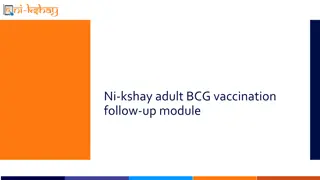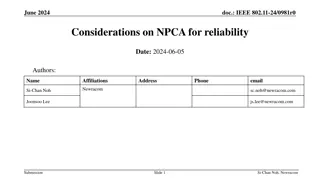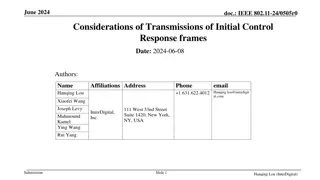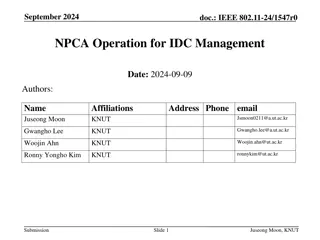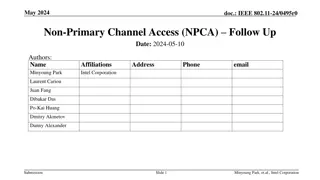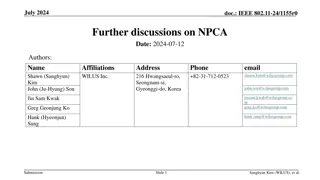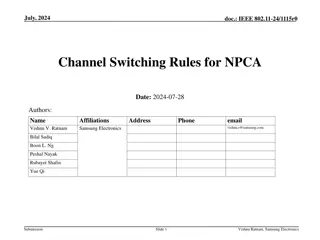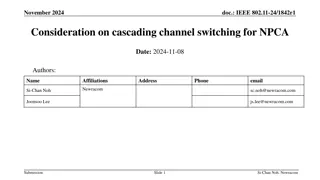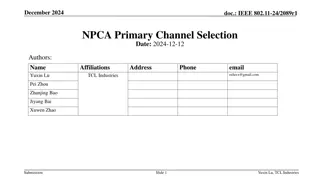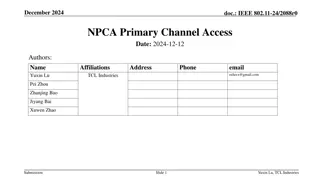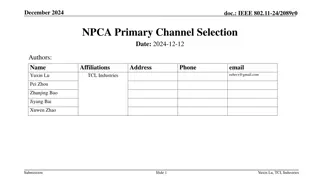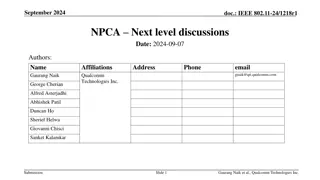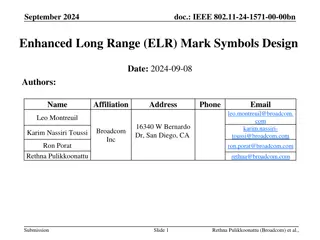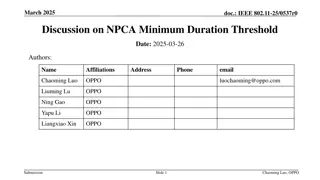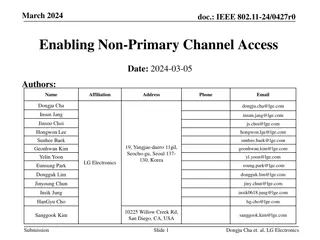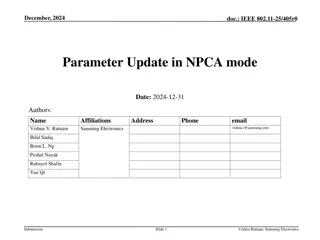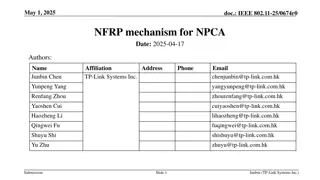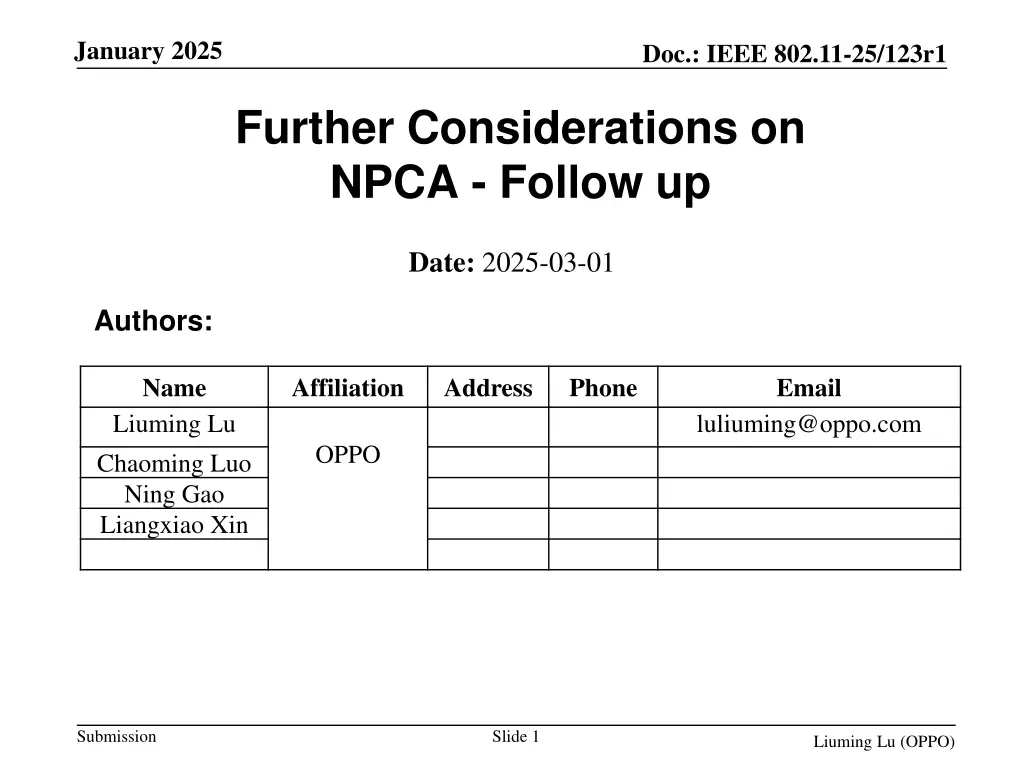
Implementing Efficient NP-Channel Access Mechanism
Explore further considerations on NP-Channel Access Mechanism in IEEE 802.11. Analyze issues arising from diverse OBSS environments triggering switches for NPCA AP and non-AP STAs. Propose solutions for ensuring synchronization in channel switching behaviors for enhanced frame exchanges.
Download Presentation

Please find below an Image/Link to download the presentation.
The content on the website is provided AS IS for your information and personal use only. It may not be sold, licensed, or shared on other websites without obtaining consent from the author. If you encounter any issues during the download, it is possible that the publisher has removed the file from their server.
You are allowed to download the files provided on this website for personal or commercial use, subject to the condition that they are used lawfully. All files are the property of their respective owners.
The content on the website is provided AS IS for your information and personal use only. It may not be sold, licensed, or shared on other websites without obtaining consent from the author.
E N D
Presentation Transcript
January 2025 Doc.: IEEE 802.11-25/123r1 Further Considerations on NPCA - Follow up Date: 2025-03-01 Authors: Name Liuming Lu Chaoming Luo Ning Gao Liangxiao Xin Affiliation Address Phone Email luliuming@oppo.com OPPO Submission Slide 1 Liuming Lu (OPPO)
January 2025 Doc.: IEEE 802.11-25/123r1 Introduction 802.11bn task group has agreed to define NPCA operation that enables a STA to access the secondary channel while the primary channel is known to be busy due to OBSS traffic. And some behaviors currently specified for NPCA operation in 11bn Draft 0.1 are based on the assumption that NPCA AP and non-AP STA detect the same OBSS traffic. But due to the complexity of OBSS environment NPCA AP and non-AP STA possibly detect different OBSS traffic that may trigger them to switch from BSS primary channel to NPCA primary channel. It would be more efficient to make sure that NPCA AP and non-AP STA(s) switch to the NPCA primary channel and do frame exchanges due to the same OBSS traffic. Therefore a mechanism is needed to have the NPCA STAs know whether their peer STA switch to the NPCA primary channel due to the same OBSS traffic. This contribution analyzes the key issues for NPCA operation due to different OBSS traffic that trigger NPCA AP and non-AP STA switch to NPCA primary channel, and proposes candidate solutions for NPCA operation to be considered. Submission Slide 2 Liuming Lu (OPPO)
January 2025 Doc.: IEEE 802.11-25/123r1 Cases for different triggering switch conditions (1) Different triggering switch conditions due to different views on OBSS An example: An NPCA AP and a NPCA non-AP STA(i.e. STA1) can detect PPDUs from OBSS1, but another NPCA non-AP STA(i.e. STA2) can only detect PPDUs from OBSS2 (1) Case 1a: inconsistent switches that result in no frame exchange completed STA2 switch to NPCA primary channel due to OBSS traffic between AP2 and STA2-1 but AP cannot switch to NPCA primary channel, therefore STA2 cannot do frame exchanges with AP. (2) Case 1b: inconsistent stay duration on NPCA primary channel due to different OBSSs Firstly STA2 switch to NPCA primary channel due to OBSS traffic between AP2 and STA2-1 Then AP and STA1 switch to the NPCA primary channel due to OBSS traffic between AP1 and STA1-1 STA2 obtains TXOP and then does frame exchanges with AP if allowed, but the TXOP duration is limited AP AP2 AP1 (NPCA AP) (3) (2) (1) STA1-1 STA1 STA2 STA2-1 OBSS1 OBSS2 Submission Slide 3 Liuming Lu (OPPO)
January 2025 Doc.: IEEE 802.11-25/123r1 Cases for different triggering switch conditions (2) Different triggering switch conditions due to different views on DL/UL for the same OBSS Another example: An NPCA AP and a NPCA non-AP STAs(i.e. STA1 and STA2) can detect PPDUs from OBSS1, but STA1 can only detect PPDUs transmitted by AP1 and cannot detect PPDUs transmitted by STA1-1 from OBSS1 (3) Case 2a: misaligned switches that also result in no frame exchange completed - as STA1 cannot receive ICF in time on NPCA primary channel Firstly AP1 does frame exchanges with STA1-1 with initial control frame exchange(such as RTS/CTS) Then AP can detect the control frame exchange from OBSS1 and switches to NPCA primary channel But STA1 cannot detect the control frame exchange, but detect the PPDU transmitted by AP1 after the control frame exchange, and then switches to NPCA primary channel. (4) Case 2b: inconsistent stay duration on NPCA primary channel even if STA1 can receive ICF in time on NPCA primary channel as different OBSS traffic is detected respectively by AP and STA1 PPDU1 PPDU1 PPDU2 PPDU2 RTS RTS AP AP1 AP1 AP1 (NPCA AP) STA1 STA1- -1 1 CTS CTS BA BA BA BA ICF ICF STA2 NPCA Pchannel NPCA Pchannel OBSS traffic OBSS traffic detected detected AP AP BSS Pchannel BSS Pchannel STA1 STA1-1 ICR ICR NPCA Pchannel NPCA Pchannel OBSS1 OBSS traffic detected OBSS traffic detected STA1 STA1 BSS Pchannel BSS Pchannel Submission Liuming Lu (OPPO) Slide 4
January 2025 Doc.: IEEE 802.11-25/123r1 Issues for different triggering switch conditions - Summary Different triggering switch conditions would result in low medium efficiency: inconsistent switches from BSS primary channel to NPCA primary channel for different NPCA STAs that result in invalid or useless switches misaligned switches from BSS primary channel to NPCA primary channel that result in failed frame exchanges. Inconsistent stay duration and/or available BW on NPCA primary channel for different NPCA STAs that have switched to NPCA primary channel that results in limited potential TXOP duration for frame exchange. A mechanism or tool is required to resolve the issues that would be helpful: NPCA STA can collect the information of the triggering switch conditions from its peer STA(s) on the NPCA primary channel and then determine the target peer STA(s) for subsequent transmission based on the information. NPCA STA can also confirm whether its peer STA switches to the NPCA primary channel due to the same OBSS traffic when it has switched to NPCA primary channel. Submission Slide 5 Liuming Lu (OPPO)
January 2025 Doc.: IEEE 802.11-25/123r1 Candidate Solution Propose to provide a mechanism for triggering switch condition report operation triggering switch condition report refers to the report on the condition of OBSS traffic that triggers NPCA STA to switch from BSS primary channel to NPCA primary channel, and its related info. may include: Whether it is consistent with the peer STA s if it knows triggering switch condition for the peer STA. Triggering condition type (HE/EHT/UHR PPDU-based or control frame exchange) OBSS color, OBSS BSSID, UL/DL, Duration, RSSI NPCA STA delivers triggering switch condition during frame exchanges on NPCA primary channel to assist its peer STA to know its triggering switch condition, that is helpful for the subsequent data frame exchanges. For example, NPCA AP send triggering switch condition report poll frame as an initial control frame to trigger its associated NPCA STAs to response with their triggering switch condition report . NPCA STA explicitly deliver triggering switch condition report in response to AP. NPCA STA can also indicate whether its triggering switch condition is consistent with AP s. triggering switch condition report Poll trigger frame triggering switch condition report AP1 AP (NPCA AP) ICF IR data frame BA NPCA primary channel AP AP STA2 STA2 STA2 STA1,2 STA1,2 STA1 STA1-1 R T S C T S OBSS PPDU BA BSS primary channel OBSS1 OBSS STA(STA1 OBSS STA(STA1- -1) 1) OBSS AP(AP1) OBSS AP(AP1) Time Time Submission Slide 6 Liuming Lu (OPPO)
January 2025 Doc.: IEEE 802.11-25/123r1 Summary There are several issues for different triggering switch conditions needed to be addressed for NPCA operation, such as Inconsistent or misaligned switches Inconsistent stay duration and/or available BW on NPCA primary channel This contribution proposes to provide a mechanism for triggering switch condition report operation to resolve the issues that would be helpful: NPCA STA can collect the triggering switch condition reports from its peer STA(s) on the NPCA primary channel and then determine the target peer STA(s) for subsequent transmission. NPCA STA can also confirm whether its peer STA switches to the NPCA primary channel due to the same OBSS traffic when it has switched to NPCA primary channel. Submission Slide 7 Liuming Lu (OPPO)
January 2025 Doc.: IEEE 802.11-25/123r1 References [1] Draft P802.11bn_D0.1 [3] non-primary channel access (NPCA) - follow up, https://mentor.ieee.org/802.11/dcn/24/11-24- 0495-00-00bn-non-primary-channel-access-npca-follow-up.pptx [4] Non-primary channel access (NPCA), https://mentor.ieee.org/802.11/dcn/23/11-23-2005-01- 00bn-non-primary-channel-access-npca.pptx Submission Slide 8 Liuming Lu (OPPO)
January 2025 Doc.: IEEE 802.11-25/123r1 SP 1 SP1: Do you support to specify a mechanism to resolve the issues due to different triggering switch conditions for NPCA operation to make sure: NPCA STA can collect the information of the triggering switch conditions from its peer STA(s) on the NPCA primary channel and then determine the target peer STA(s) for subsequent transmission based on the information. NPCA STA can also confirm whether its peer STA switches to the NPCA primary channel due to the same OBSS traffic when it has switched to NPCA primary channel. The mechanism is TBD Submission Slide 9 Liuming Lu (OPPO)
January 2025 Doc.: IEEE 802.11-25/123r1 SP 2 SP 2: Do you support to specify a mechanism for triggering switch condition report operation? The mechanism is TBD Submission Slide 10 Liuming Lu (OPPO)


